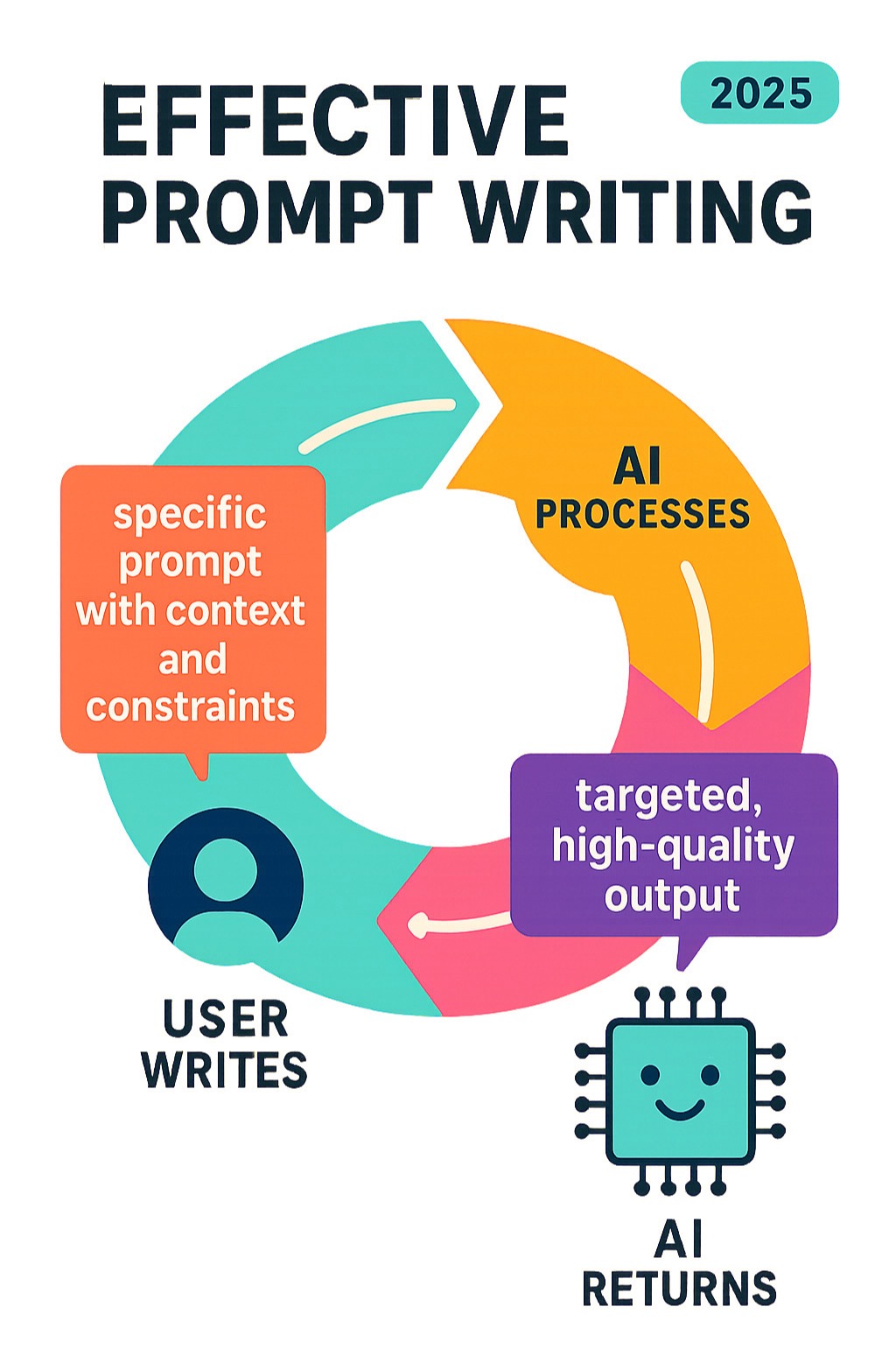Unlock AI's Full Potential with Effective Prompt Writing and Optimization
Why Effective Prompt Writing is Your Gateway to AI Success

Effective prompt writing is the skill of crafting clear instructions to guide AI models toward the exact output you need. It's the difference between generic responses and opening up AI's true potential.
Quick Guide to Effective Prompt Writing:
- Be specific: Use clear action verbs and detailed instructions.
- Provide context: Give background information and define your audience.
- Set constraints: Specify format, length, and tone.
- Use examples: Show the AI what good output looks like.
- Iterate and refine: Test different approaches and improve based on results.
Many professionals get mediocre results from AI because they haven't learned to communicate effectively with these systems. As one expert noted, "Writing effective prompts that drive consistent results can feel more like an art than a science."
But it doesn't have to be mysterious. Effective prompt writing follows proven principles that anyone can learn. Mastering these techniques will transform your AI interactions from frustrating trial-and-error into powerful, predictable workflows. The quality of your AI output is directly tied to the quality of your prompts. Vague instructions lead to generic responses, while specific, contextual prompts deliver valuable results.
This guide will cover everything from basics to advanced techniques, helping you build a systematic approach to AI communication that saves time and delivers better outcomes.

The Core Principles of Foundational Prompting
Think of AI as a brilliant intern who needs clear direction. The more specific and thoughtful your instructions, the better the output. Effective prompt writing is goal-oriented communication; your job is to guide the AI with precision and clarity.

A helpful framework for building strong prompts is the 5C Framework: Clarity, Contextualization, Command, Chaining, and Continuous Refinement. These principles transform vague requests into precise instructions. The foundation of great prompting lies in providing examples and structuring your requests thoughtfully to set the AI up for success.
The Importance of Clarity, Conciseness, and Specificity
AI works literally: vague prompts produce vague results, while specific instructions lead to targeted output.
Start with strong action verbs like "Generate," "Summarize," or "Analyze" to set clear expectations. Instead of "Tell me about social media marketing," try "Generate three Instagram content strategies for a local bakery targeting young professionals."
Avoiding ambiguity is crucial. Replace "Make this better" with "Rewrite this paragraph to sound more conversational and include specific examples." This eliminates guesswork about whether you want to improve grammar, style, or tone.
Finally, positive framing works better than negative instructions. Instead of "Don't use technical jargon," say "Use simple language a beginner would understand." This gives the AI a clear target to aim for.
Providing Sufficient Context and Background
Context is the roadmap for your request. Without it, AI responses are generic. Setting the scene with background information helps the AI narrow its focus to fit your needs.
For example, "Explain blockchain" is vague. "Explain blockchain to a small business owner with no technical background who is considering accepting cryptocurrency" provides crucial context about the audience, purpose, and knowledge level.
Defining your audience is key, as it shapes vocabulary and depth. Context also helps mitigate bias. AI models learn from data that can reflect societal biases. A concerning example emerged when an MIT student asked AI to make her headshot more professional, and it gave her lighter skin and blue eyes. By providing specific context, you reduce AI guesswork and guide it toward more inclusive results.
Defining Your Objective and Desired Output Format
Before writing, get clear on your goal. This objective guides every part of your prompt. Then, specify the output format. AI can generate content in dozens of different formats, from a bulleted list to structured JSON data. If you don't specify, you'll get the AI's best guess.
Common formats include plain text, lists, tables, code snippets, email templates, social media posts, summaries, and structured data like JSON or CSV.
Setting constraints is powerful. Specify word counts ("in under 200 words"), tone ("friendly but professional"), or structure ("include three main points"). Instead of "Summarize this report," try "Create a 150-word executive summary of this quarterly report for senior leadership, highlighting the three most important findings and their business implications." This level of specificity is the hallmark of effective prompt writing.
Advanced Techniques to Lift Your Prompts
Once you have the basics, advanced techniques can transform your AI interactions into sophisticated collaborations.

Think of these as power tools for effective prompt writing. Few-shot prompting involves showing the AI examples to teach it a pattern. Chain-of-thought prompting asks the AI to explain its reasoning, improving accuracy on complex problems. And surprisingly, research shows that being polite can generate more thoughtful responses.
Assigning a Persona: The "Act As" Method
To get expert-level insights, use the "Act As" method. Tell the AI to "Act as an experienced financial advisor" or "You are a seasoned marketing strategist." The AI will frame its response through that expert's lens, making the language more precise and the advice more actionable.
This role-playing technique gives the AI a clear mental model. A prompt for investment advice gets a different response when you specify "Act as a conservative financial planner" versus "Act as a venture capitalist." This method is especially useful for complex, subjective tasks, like asking the AI to "Act as a devil's advocate and critique this business plan."
Structuring Complex Requests with Task Splitting and Chaining
For large projects, break them down into sequential steps. This principle is crucial for effective prompt writing. Instead of "Create a comprehensive marketing strategy," start with "Outline the key components of a digital marketing strategy." Then, build on that with subsequent prompts.
This chaining approach keeps the AI focused on each subtask, allows you to course-correct, and results in a more thorough final product. Ensure a logical flow between prompts, with each new instruction referencing previous outputs to guide the AI through the project.
Leveraging Examples and Feedback for Precision
The fastest way to teach AI is by showing, not just telling. Providing clear examples of what you want gives the AI a concrete reference point. If you need product descriptions in a specific style, show it a few perfect examples.
Effective prompt writing also involves a feedback loop. If an output isn't right, give specific, constructive feedback: "That's good, but make it more conversational." This iterative approach treats the AI as a collaborative partner. Each round of feedback trains the AI to better understand your preferences and meet your standards, changing it from a simple tool into a creative partner.
The Iterative Process: Achieving Effective Prompt Writing Through Refinement
Effective prompt writing is an iterative process, much like cooking. You rarely get it perfect on the first try; instead, you test, adjust, and refine. Embracing an experimentation mindset is key.

Each attempt is a learning opportunity. Smart prompt writers use A/B testing—crafting two slightly different prompts to see which performs better. Versioning your prompts, much like developers version code, allows you to revert to successful versions and build upon them. This cycle of continuous improvement is what separates good prompt writers from great ones.
Starting Simple and Building Complexity
To avoid frustration, start with the simplest version of your prompt. For example, instead of a complex request for marketing copy, begin with: "Write a product description for our new running shoes."
Once you see the output, you can evaluate each change as you add complexity. You might then refine the prompt to: "Write a casual, energetic product description for our new running shoes aimed at weekend runners, highlighting comfort and durability in under 100 words."
This gradual building approach helps you understand how each instruction affects the output and find the sweet spot between providing enough detail and over-engineering the prompt.
The Art of Analyzing Responses and Refining Your Approach
Getting a response is where the real skill of effective prompt writing begins. You must analyze what worked and what didn't.
Identify gaps in the output: Did the AI miss a key request? Is the tone or format wrong? These gaps show where your prompt needs improvement. Also, look for signs of misunderstanding, where the AI interpreted your words differently than intended.
You can give the AI corrective feedback directly, such as "That's helpful, but can you make it more conversational?" or "Focus more on the benefits, not the features." Don't be afraid to ask the AI for clarification with prompts like, "What additional information would help you write a better response?"
This back-and-forth conversation is transformative. For more strategies, How to write effective prompts for ChatGPT offers additional insights.
Common Pitfalls and AI Limitations to Understand
Understanding common stumbling blocks and the inherent quirks of AI is as important as knowing the best practices for effective prompt writing. Common traps include overwhelming the AI with irrelevant context or using ambiguous instructions. For now, mastering explicit prompt engineering is our responsibility.

Avoiding Vague Instructions and Insufficient Constraints
Vagueness is the silent killer of good AI output. Imprecise instructions force the AI to guess, leading to generic responses and wasted time. Setting clear boundaries is essential.
For example, "Give me a list of unmanaged devices" is vague. A better prompt is: "Give me a list of high-risk unmanaged devices in my corporate network. If any are named 'test', remove them from the list." This sets explicit rules and removes guesswork.
Also, telling the AI what to do works better than telling it what not to do. Instead of "Don't include jargon," say "Use simple, everyday language that a beginner would understand." This gives the AI a positive target to aim for.
Understanding Inherent AI Limitations: Hallucinations and Bias
AI isn't perfect and has real limitations. AI hallucination is a primary concern, where the system confidently presents factual inaccuracies or fabricated content as truth. It might invent quotes, statistics, or entire events. When AI Chatbots Hallucinate offers eye-opening examples.
Training data bias is also problematic. AI models learn from datasets that can reflect societal biases, leading to discriminatory or stereotypical responses. For instance, when an MIT student asked an AI to make her headshot more professional, it altered her racial features by giving her lighter skin and blue eyes, reflecting a biased view of "professionalism."
Because of these issues, human oversight and fact-checking are essential. Always review, verify, and apply critical thinking to AI-generated content, especially when the information is important. Understanding these limitations allows you to use AI tools responsibly and effectively.
Frequently Asked Questions about Effective Prompt Writing
Here are answers to common questions about effective prompt writing.
Do I need to be a programmer to write good prompts?
No. Effective prompt writing is not about coding; it's about clear communication in everyday language. If you can write a detailed email or give clear directions, you have the foundational skills. It's about organizing your thoughts, providing context, and being specific—human skills, not technical ones.
How long should a prompt be?
There's no magic length. The best prompt is long enough to be clear without adding unnecessary detail. Simple tasks can use short prompts, while complex requests benefit from longer, structured instructions. The goal is to balance context with conciseness, as both the prompt and response count toward model limits.
How do I know if my prompt is effective?
You'll know your prompt is effective by the quality and consistency of the results. The output should match your desired format, content, and tone with minimal need for re-prompting. When you can run the same prompt multiple times and get consistently good responses, you've achieved effective prompt writing. The ultimate test is whether it saves you time and delivers valuable results.
Conclusion: Transform Your AI Interactions Today
We've covered the journey of effective prompt writing, from foundational principles to advanced techniques like assigning personas and task chaining. You now have a toolkit for better AI communication.
This skill is entirely learnable and relies on structured thinking and clear communication, not a computer science degree. Mastering prompting opens up AI's true potential as a creative partner and problem-solving companion, fundamentally changing how you work. Every well-crafted prompt bridges human creativity and machine capability.
You don't have to build this expertise alone. The iterative process of testing and refining is more powerful when you can learn from others.
On platforms like Potions, you can find, remix, and evolve proven prompts from a community, using version control to track experiments and build on collective knowledge. Instead of starting from scratch, you can adapt what works and contribute your improvements.
This transforms effective prompt writing from a solo skill into a shared craft.
Ready to take your AI interactions to the next level?